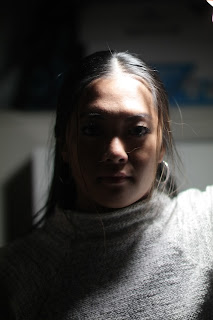Ryan McGinley’s show “Mirror, Mirror” was displayed at Team Gallery in Soho. The venue was very minimalist as a wide space with three white walls and gray flooring. The photographs were taken on a Yashica T4 camera with 35mm film and were displayed on canvases. The photographs were displayed in groups of two, with ten canvases total on opposite walls and four canvases on the adjacent wall. McGinley’s work consists of nude “selfies” taken by subjects of all different sizes between the ages of 19-87, in the privacy of their homes. The subjects were “provided with a camera, a set of instructions, five rolls of 35mm film, and 20 mirrors that were delivered to their homes. The undeveloped rolls of film were returned to McGinley, who sorted through the material and selected a single image to represent each participant.” (press release) The participants decided how much of the body and their personalities they wanted to show.
The subject of the photographs was how the self-portraits transmitted intimate information about the subjects’ emotional state as well as who their idealized physical self is. The subject matter consists of the models, the mirrors, and the intimate privacy of their homes. In terms of form, the self-portraits portrayed straight lines from the mirrors as well as curves from the subjects’ bodies. The shape of the subjects’ bodies was saliently captured. The color scheme of the images varied from the difference in backgrounds of the subjects’ homes. The natural light coming from the windows and the artificial lights of the rooms gave the subjects shadows which added depth and contrast. The photographs portrayed individuals of different races, body types, and gender in a nude state in front of, behind, or with different amounts of mirrors. The style of the photos is consistent with McGinley’s previous work as his themes consist of nudity, sexuality, gender, beauty, and fantasy. In terms of internal and external context, I had been following McGinley on social media and found out about his show through Instagram. I also received external context from the press release. At the show, none of the photos had descriptions so the viewer had to interpret the photos by paying attention to its subject matter, medium, and form while pulling from your own experiences and knowledge. Subject matter was significantly important when interpreting this photo because the people in the photos were also the one’
The idea of McGinley’s work made me feel uncomfortable because I was technically looking at random strangers’ nudes but after seeing the photos in person and seeing the subjects’ personalities through how they took the photo, how much they wanted to show, and the context of their room made me have a better understanding and appreciation for what McGinley’s subjects accomplished.
A particular image that stood out to me was of a man named Hunter. His photograph consisted of what seemed to be seven or eight mirrors of different sizes lined up in a row as well as a few behind him in his room. In the photo, Hunter is fully frontal nude and he is posing with his left arm up while his right hand presses the shutter. What stood out about this image is that the placement of the mirrors lined up next to each other creates repetition within the image as the viewer sees Hunter from multiple angles in all of the mirrors. Although there is a sense of repetition, each angle allows viewer to see different sides of Hunter and the viewer essentially sees him fully nude from looking at his reflection captured through the mirror. Compared to the other pieces shown, the viewer can tell that Hunter was really comfortable with his body because of the amount of skin he showed as well as the multiple angles he set up within the photo. His personality shows in this portrait through his pose; he’s looking directly into the camera with a straight face, his left arm is above his head and his right leg is slightly inverted.
Overall, I enjoyed the photos that were shown. Although I have never taken a nude, I can appreciate the intent of the message Ryan McGinley attempted to achieve; that mirrors can promote body positivity and how the media influences how we see ourselves. I thought the use of a film camera was a genius idea because the models couldn’t look back and censor themselves. The project promotes body positivity and self-confidence which I find worked well as the viewer got to see the subjects in their element. Although McGinley provided the instructions and the materials, I think that by allowing the subjects to be in control of the project, the results were more authentic and relatable. I would definitely want to see more of his work.
References
http://famedriver.com, Fame Driver. “Mirror, Mirror.” Ryan McGinley : Mirror, Mirror, Team (Gallery Inc.), 2018, www.teamgal.com/exhibitions/391/mirror_mirror.














